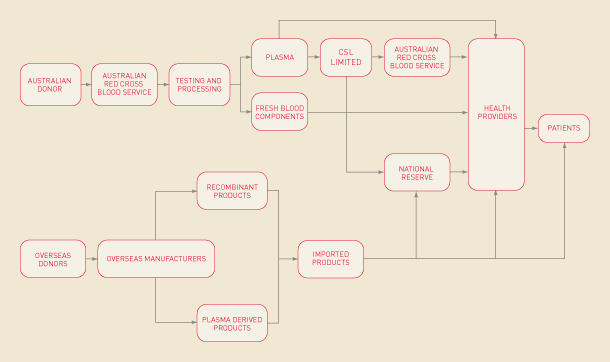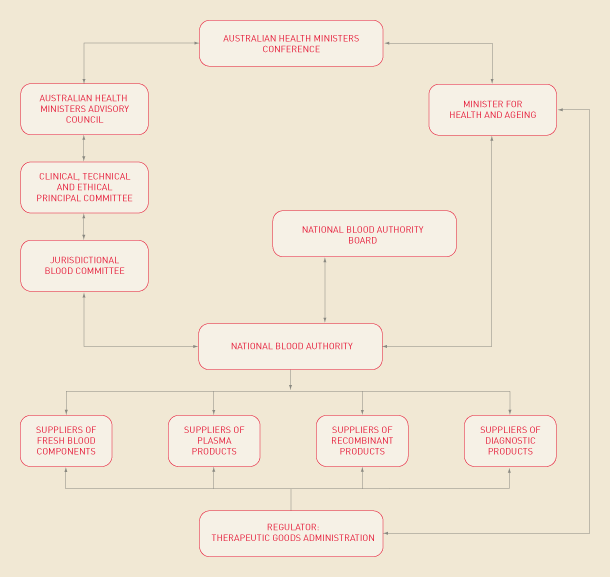

Australia’s blood sector is funded by the Australian and state and territory governments, with contributions of 63 per cent and 37 per cent respectively. In 2008–09 governments provided $806.8 million for the purpose of procuring and managing Australia’s blood supply (see Table 1.1).
Since the establishment of the NBA, governments have spent $3740.4 million on blood and blood-related products. Table 1.2 shows government funding for the operation of the NBA over the same period.
| Year | Amount ($m) | Growth (%) |
|---|---|---|
| 2003–04 | 460.5 | … |
| 2004–05 | 536.8 | 16.6 |
| 2005–06 | 577.4 | 7.6 |
| 2006–07 | 639.4 | 10.8 |
| 2007–08 | 719.5 | 12.5 |
| 2008–09 | 806.8 | 12.1 |
| Total | 3740.4 | 11.9 (average) |
| Year | Amount ($m) | Growth (%) |
|---|---|---|
| 2003–04 | 7.4 | … |
| 2004–05 | 8.4 | 12.7 |
| 2005–06 | 10.4 | 24.1 |
| 2006–07 | 10.1 | –2.6 |
| 2007–08 | 9.6 | –4.8 |
| 2008–09 | 9.2 | –4.9 |
The NBA manages the national planning and purchasing of blood and blood-related products in close cooperation with a number of stakeholders. The following pages outline the roles and responsibilities of the key stakeholders in the Australian blood sector.
As signatories to the National Blood Agreement, the Australian, state and territory governments are responsible for:
The Therapeutic Goods Administration is the regulator for blood and blood-related products in Australia. It is responsible for:
The NBA contracts with a number of suppliers of blood and blood-related components and products, including:
Contracts with suppliers for the provision of blood and blood-related products under standing offer arrangements include:
Figure 1.1 shows the location of these stakeholders in the blood supply chain.
FIGURE 1.1 The Australian blood supply chain

The key governing bodies in the Australian blood sector, their roles and relationships with each other are set out in the National Blood Agreement and the National Blood Authority Act 2003. Figure 1.2 shows the governance structure of the sector.
The Australian Health Ministers Conference is responsible for overseeing and managing the blood sector in conjunction with the Australian Government. It sets the governance, policy and financial frameworks under which the NBA operates. In 2008–09 key decisions made by ministers included:
Under the National Blood Authority Act 2003 the Minister for Health and Ageing, the Hon Nicola Roxon MP, is responsible for issuing policy principles with which the NBA must comply in performing its functions, for the appointment of the NBA Board and General Manager, and for determining additional functions of the NBA. The Minister carries out these statutory roles with endorsement from all health ministers in the Australian Health Ministers Conference.
FIGURE 1.2 Governance structure of the Australian blood sector

Senator the Hon Jan McLucas, Parliamentary Secretary to the Minister for Health and Ageing, was responsible for oversight of the NBA until she retired from ministerial responsibilities. The Hon Mark Butler MP was appointed as Parliamentary Secretary on 9 June 2009.
The Australian Health Ministers Advisory Council provides support to the Australian Health Ministers Conference. It advises ministers on strategic matters relating to the coordination of health services across the nation and, as necessary, with New Zealand. The Council considers blood sector matters referred to it by the Jurisdictional Blood Committee through the Clinical, Technical and Ethical Principal Committee and reports, as necessary, to the Australian Health Ministers Conference. The Council has no statutory power and decisions are reached by consensus.
The Clinical, Technical and Ethical Principal Committee was established in 2006 to consider and provide advice to the Australian Health Ministers Advisory Council on a range of issues such as: clinical, technical and medico-ethical developments that are likely to affect more than one jurisdiction; options for ongoing coordination of the clinical and technical services that are managed on a national basis; the appropriateness, effectiveness and safety of clinical and technical developments; any policy implications arising from such issues; the impact of clinical and technical developments on the delivery and management of health care and other services; and the impact of such developments outside the health care sector.

JBC member Joan Bedford in discussion with CTEPC Member Simon Towler (centre) and JBC Proxy member Ashley Eccles at the NBA Blood Sector Conference.
All Australian governments are represented on the Jurisdictional Blood Committee, which was established by the National Blood Agreement in 2003. The Committee is the conduit between governments and the NBA. It represents the Australian, state and territory governments’ positions on blood policy, demand, supply planning and product distribution, funding, and evidence-based approaches to emerging products, services and technologies. It oversees the NBA’s role in blood supply contracting. It is also the primary body responsible for providing advice and support on these matters to the Australian Health Ministers Conference through the Clinical, Technical and Ethical Principal Committee (of which it has been a subcommittee since September 2006) and the Australian Health Ministers Advisory Council.
The NBA Board is responsible for providing to the General Manager advice about the performance of the NBA. It also liaises with governments, suppliers and other stakeholders on matters relating to the NBA’s functions. The NBA Board is an advisory body: it has no capacity to engage personnel or to enter into dealings with other parties, nor does it have a governance role.
The NBA’s performance obligations are determined by the Agency Outcome and Output Group, as reported in the Health and Ageing Portfolio Budget Statements 2008–09. Part 2 provides details on the performance against these key performance indicators and other specific activities in 2008–09.